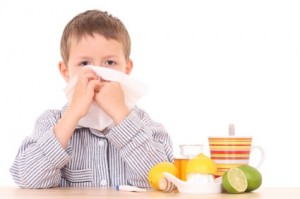 A well-known proverb states that “idle hands are the devil’s playthings.” The saying implies that individuals who are not occupied with productive work are likely to get into mischief. You may or may not believe in that theory (I know I enjoy a smidge of idleness every now and then…), but one hypothesis about the modern rise of allergies provides support from an unlikely source for the ancient saying.
A well-known proverb states that “idle hands are the devil’s playthings.” The saying implies that individuals who are not occupied with productive work are likely to get into mischief. You may or may not believe in that theory (I know I enjoy a smidge of idleness every now and then…), but one hypothesis about the modern rise of allergies provides support from an unlikely source for the ancient saying.
The hypothesis in question is called the hygiene hypothesis, and the idle hands in question are the (metaphorical) hands of the human immune system. This theory, first formally detailed in 1989 by scientist David P. Strachan, proposes that our successful battle against germs and many forms of disease have left our immune systems with little to do but engage in warfare with harmless substances.
What Are Allergies?
In order understand the hygiene hypothesis, it is important to understand where allergies actually come from. Allergy symptoms are caused by chemicals that our bodies themselves release in response to the detection of an antigen. Antigens are foreign substances, and many are harmful invaders such as viruses or bacteria. However, many other antigens are completely benign and will not cause any illness or immune system reaction in most hosts.
Unfortunately, some individuals react negatively to certain substances called allergens. There area many common allergens such as dust and mold, but allergens can also take the unlikely form of things like sunlight, heat, or cold. When these allergens are detected by sensitive individuals, the immune system responds by releasing chemicals called antibodies to attack these allergens.
In many cases, these antibodies can cause inflammation, itchiness, mucus production, nausea, abdominal pain, and other symptoms ranging from mild to severe. Mild sensitivity or minimal exposure can result in mild or localized reactions, but some severe sensitivities can cause reactions throughout the body that can be life threatening.
The Mystery Of Allergies
So why do these allergies to harmless substances appear? That, as Hamlet would say, is the question. The exact cause of allergies has long been something of a mystery, and there are many unresolved questions about how, when, and why they occur. There does seem to be a genetic factor, because individuals whose parents both suffer from allergies are significantly more likely to have allergies themselves. Nevertheless, specific allergies are very rarely passed from parents to children.
The truth behind allergies has become a particularly popular subject of research and speculation in recent years. This is largely because the incidence of allergies has been – and still is – on the rise. Food and environmental allergies have grown in number to the point where nearly one in five residents of the United States suffers from one or more allergies.
Early Exposure to Allergens
In addition to the “bored immune system” component of the hygiene hypothesis, this theory also identifies the importance of our early developmental years in the formation of allergies. Babies and young children do not have fully developed immune systems, and parents are naturally worried that any viral or bacterial infection in their child could result in a very serious illness.
In consequence, most parents or other caregivers are hypersensitive about hygiene. They do their best to eradicate any dirt, dust, or germs that might exist in their home environment and to keep their child from exposure to germs in outside environments as well. Soaps, disinfectant sprays, hand sanitizers, and the like all come into play to ensure that our children are surrounded by cleanliness to the point of sterility.
However, the results of studies to test the viability of the hygiene hypothesis support the idea that exposure to a certain amount of dirt and other “unsanitary” substances is actually an important part of human immunological development. Without this exposure, the hygiene hypothesis theorizes that our immune systems are never given the necessary information and exercise necessary to develop the correct responses to different types of antigens.
This theory is also supported by surveys that show marked differences in the incidence of allergies between developed and developing countries and between urban and rural residents. Rural or agrarian settings provide children with a greater variety of germ exposure, while urban settings are more controlled and more likely to isolate children from as many germs as possible. Growing up in undeveloped areas or on farms also means that children are often involved in work or play that involves getting dirty.
Children who have older siblings or attend day are centers on a regular basis are also less likely to develop allergies. Only children who are not given many opportunities to play with other kids are significantly more likely to develop allergies. Of course, this doesn’t mean that you shouldn’t keep your child home for a few days if a flu epidemic is sweeping their day care facility. But it definitely supports the idea that even a few unhealthy germs can be the healthiest thing in the long term.
Other Allergy Theories
Although a variety of theories to explain the growth of allergies have been proposed, hygiene theory is the lone credible theory left standing and the one that is generally accepted by most experts. Other theories have come and gone, discredited as more and more information about allergy statistics from around the world became available.
One such theory was the hypothesis that the rise in allergies was caused by the increase in environmental pollutants in the air, water, and many household items. However, comparisons of allergy incidence in East Germany and West Germany after the fall of the Berlin Wall seemed to contradict this theory. Although there was significantly more pollution on the East German side of the wall, there was a significantly lower rate of allergies. However, the data was consistent with the hygiene theory because of the generally wealthier and cleanlier environments in West Germany.
Let Kids Be Kids – Mostly
So how do we go about striking a good balance between protecting our children from serious illness and giving them just enough exposure to unfriendly invaders that they develop strong defenses? The answer, as it so often is, seems to be moderation.
For one thing, it is important to recognize the difference between illnesses that even a child’s immune system can deal with competently, and illnesses that generally overpower even hardy adults. There is no reason to live in fear of the common cold or other minor infections – they are unpleasant, but they will pass without any long-term detrimental effects. Let your kids make mud pies, have play dates, and climb on public playgrounds.
However, the hygiene theory is not a reason to avoid getting necessary vaccines or taking other preventative measures against dangerous illnesses. Exposure to polio or tetanus is not going to strengthen your immune system in the long run; it is probably just going to kill you in the long run. There are some things that even the most robust immune system is not equipped to battle, and people should not be deliberately reckless or overly careless when it comes to their own or their child’s health.
Questions Remain
While the hygiene theory may seem to satisfactorily explain the modern explosion of allergy cases, it still leaves many questions about allergies unanswered. Perhaps the fundamental question remains why the phenomenon of allergy exists at all – why do some immune systems identify certain substances as harmful that are entirely innocuous to the majority of the population? What causes that particular substance to trigger a response, when so many other harmless antigens are treated as just that? These are questions that it will probably take more than a proverb to explain.
©2012 Off the Grid News
 Off The Grid News Better Ideas For Off The Grid Living
Off The Grid News Better Ideas For Off The Grid Living



